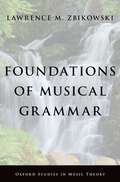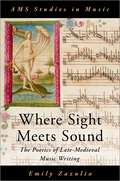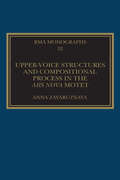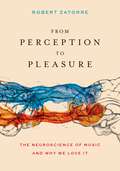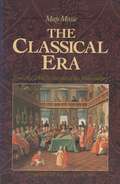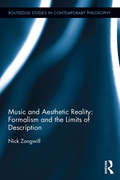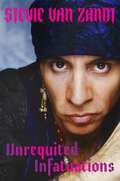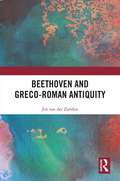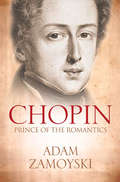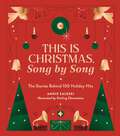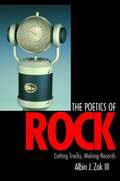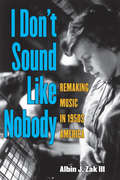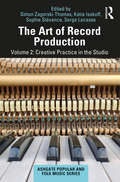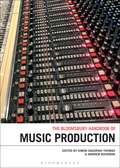- Table View
- List View
Foundations of Musical Grammar (Oxford Studies in Music Theory)
by Lawrence M. ZbikowskiIn recent years, music theorists have been increasingly eager to incorporate findings from the science of human cognition and linguistics into their methodology. In the culmination of a vast body of research undertaken since his influential and award-winning Conceptualizing Music (OUP 2002), Lawrence M. Zbikowski puts forward Foundations of Musical Grammar, an ambitious and broadly encompassing account on the foundations of musical grammar based on our current understanding of human cognitive capacities. Musical grammar is conceived of as a species of construction grammar, in which grammatical elements are form-function pairs. Zbikowski proposes that the basic function of music is to provide sonic analogs for dynamic processes that are important in human cultural interactions. He focuses on three such processes: those concerned with the emotions, the spontaneous gestures that accompany speech, and the patterned movement of dance. Throughout the book, Zbikowski connects cognitive research with music theory for an interdisciplinary audience, presenting detailed musical analyses and summaries of the basic elements of musical grammar.
Foundations of Musical Grammar (Oxford Studies in Music Theory)
by Lawrence M. ZbikowskiIn recent years, music theorists have been increasingly eager to incorporate findings from the science of human cognition and linguistics into their methodology. In the culmination of a vast body of research undertaken since his influential and award-winning Conceptualizing Music (OUP 2002), Lawrence M. Zbikowski puts forward Foundations of Musical Grammar, an ambitious and broadly encompassing account on the foundations of musical grammar based on our current understanding of human cognitive capacities. Musical grammar is conceived of as a species of construction grammar, in which grammatical elements are form-function pairs. Zbikowski proposes that the basic function of music is to provide sonic analogs for dynamic processes that are important in human cultural interactions. He focuses on three such processes: those concerned with the emotions, the spontaneous gestures that accompany speech, and the patterned movement of dance. Throughout the book, Zbikowski connects cognitive research with music theory for an interdisciplinary audience, presenting detailed musical analyses and summaries of the basic elements of musical grammar.
Where Sight Meets Sound: The Poetics of Late-Medieval Music Writing (AMS Studies in Music)
by Emily ZazuliaThe main function of western musical notation is incidental: it prescribes and records sound. But during the fourteenth and fifteenth centuries, notation began to take on an aesthetic life all its own. In the early fifteenth century, a musician might be asked to sing a line slower, faster, or starting on a different pitch than what is written. By the end of the century composers had begun tasking singers with solving elaborate puzzles to produce sounds whose relationship to the written notes is anything but obvious. These instructions, which appear by turns unnecessary and confounding, challenge traditional conceptions of music writing that understand notation as an incidental consequence of the desire to record sound. This book explores innovations in late-medieval music writing as well as how modern scholarship on notation has informedsometimes erroneouslyideas about the premodern era. Drawing on both musical and music-theoretical evidence, this book reframes our understanding of late-medieval musical notation as a system that was innovative, cutting-edge, and dynamicone that could be used to generate music, not just preserve it.
Where Sight Meets Sound: The Poetics of Late-Medieval Music Writing (AMS Studies in Music)
by Emily ZazuliaThe main function of western musical notation is incidental: it prescribes and records sound. But during the fourteenth and fifteenth centuries, notation began to take on an aesthetic life all its own. In the early fifteenth century, a musician might be asked to sing a line slower, faster, or starting on a different pitch than what is written. By the end of the century composers had begun tasking singers with solving elaborate puzzles to produce sounds whose relationship to the written notes is anything but obvious. These instructions, which appear by turns unnecessary and confounding, challenge traditional conceptions of music writing that understand notation as an incidental consequence of the desire to record sound. This book explores innovations in late-medieval music writing as well as how modern scholarship on notation has informedsometimes erroneouslyideas about the premodern era. Drawing on both musical and music-theoretical evidence, this book reframes our understanding of late-medieval musical notation as a system that was innovative, cutting-edge, and dynamicone that could be used to generate music, not just preserve it.
Zayn: The Official Autobiography
by Zayn***NOMINATED FOR THE NME BEST BOOK AWARD 2017 *** The first and only OFFICIAL book from ZAYN, for his ultimate fans. Zayn's autobiography features exclusive, never-before-seen photographs alongside his story. -------------------------------- 'This book is my diary of a period that I would like to share with you all. I hope that there are things in the book that contextualise some of the moments and memories we have all shared together. There are things I address in the book that are very personal to me, things that I have never told anyone, things I still find hard to talk about. It's a part of a journey I'm still on' - ZAYN ZAYN opens up with this collection of thoughts, inspiration, and never-before-seen personal photographs. After five years of massive success with One Direction, ZAYN launched his career as a solo artist with Mind of Mine, becoming one of the most successful artists in the world. Now, for the first time ever, ZAYN is going to tell and show all in this intimate and raw scrapbook of his life. Never-before-released photos give readers insight to ZAYN, no-holds-barred. Gorgeously designed with hundreds of full-color photographs and Zayn's notes, drawings, song lyrics, and personal stories, the book captures Zayn's most private moments and his candid feelings on fame, success, music, and life. The next chapter of ZAYN'S evolution into global superstar, told by the artist who is living it. Global superstar ZAYN shares a photographic journey of his life since leaving One Direction. *** Reviews for Mind of Mine: "A singer eager to reclaim the parts of himself that five years in the pop klieg lights forced into the shadows." -The New York Times "Sonically, you won't find many pop albums in 2016 more immaculately conceived than this." -SPIN "Sublime." -USA Today "Malik can sing . . . he's done this before, but not like this." -Rolling Stone "A moody, deeply textured R&B album..." -Los Angeles Times "Zayn has clearly achieved his aim of making an album of sexy, credible pop-R&B." -NME
Upper-Voice Structures and Compositional Process in the Ars Nova Motet (Royal Musical Association Monographs)
by Anna ZayaruznayaIn the motets of Philippe de Vitry, Guillaume de Machaut, and their contemporaries, tenors have often been characterized as the primary shaping forces, prior in conception as well as in construction to the upper voices. Tenors are shaped by the interaction of talea and color, medieval terms now used to refer to the independent repetition of rhythms and pitches, respectively. The presence in the upper voices of the periodically repeating rhythmic patterns, often referred to as "isorhythm," has been characterized as an amplification of tenor structure. But a fresh look at the medieval treatises suggests a revised analytical vocabulary: for many fourteenth- and fifteenth-century writers, both color and talea involved rhythmic repetition, the latter in the upper voices specifically. And attention to upper-voice taleae independently of tenor structures brings renewed emphasis to the significant portion of the repertory in which upper voices evince formal schemes that differ from those in the tenors. These structures in turn suggest a revision of the presumed compositional process for motets, implying that in some cases upper-voice text and forms may have preceded the selection and organization of tenors. Such revisions have implications for hermeneutic endeavors, since not only the forms of motet voices but the meanings of their texts change, depending on whether analysis proceeds from the tenor up, or from the top down. Where the presumed compositional and structural primacy afforded to tenors has encouraged a strand of interpretation that reads the upper-voice poetry as conforming to, and amplifying, the tenor text snippets and their liturgical contexts, a "bottom-down" view casts tenors in a supporting role and reveals the poetic impulse of the upper voices as the organizing principle of motets.
Upper-Voice Structures and Compositional Process in the Ars Nova Motet (Royal Musical Association Monographs)
by Anna ZayaruznayaIn the motets of Philippe de Vitry, Guillaume de Machaut, and their contemporaries, tenors have often been characterized as the primary shaping forces, prior in conception as well as in construction to the upper voices. Tenors are shaped by the interaction of talea and color, medieval terms now used to refer to the independent repetition of rhythms and pitches, respectively. The presence in the upper voices of the periodically repeating rhythmic patterns, often referred to as "isorhythm," has been characterized as an amplification of tenor structure. But a fresh look at the medieval treatises suggests a revised analytical vocabulary: for many fourteenth- and fifteenth-century writers, both color and talea involved rhythmic repetition, the latter in the upper voices specifically. And attention to upper-voice taleae independently of tenor structures brings renewed emphasis to the significant portion of the repertory in which upper voices evince formal schemes that differ from those in the tenors. These structures in turn suggest a revision of the presumed compositional process for motets, implying that in some cases upper-voice text and forms may have preceded the selection and organization of tenors. Such revisions have implications for hermeneutic endeavors, since not only the forms of motet voices but the meanings of their texts change, depending on whether analysis proceeds from the tenor up, or from the top down. Where the presumed compositional and structural primacy afforded to tenors has encouraged a strand of interpretation that reads the upper-voice poetry as conforming to, and amplifying, the tenor text snippets and their liturgical contexts, a "bottom-down" view casts tenors in a supporting role and reveals the poetic impulse of the upper voices as the organizing principle of motets.
Crying in H Mart: A Memoir
by Michelle ZaunerFrom the indie rockstar Japanese Breakfast, and author of the viral 2018 New Yorker piece that shares the title of this book, an unflinching, powerful memoir about growing up mixed-race, of Korean food, losing her Korean mother, and forging her own identity.In this exquisite story of family, food, grief, and endurance, Michelle Zauner proves herself far more than a dazzling singer, songwriter, and guitarist. With humour and heart, she tells of growing up the only Asian-American kid at her school in Eugene, Oregon; of struggling with her mother’s particular, high expectations of her; of a painful adolescence; of treasured months spent in her grandmother’s tiny apartment in Seoul, where she and her mother would bond, late at night, over heaping plates of food. As she grew up, moving to the east coast for college, finding work in the restaurant industry, performing gigs with her fledgling band – and meeting the man who would become her husband – her Koreanness began to feel ever more distant, even as she found the life she wanted to live. It was her mother’s diagnosis of terminal pancreatic cancer, when Michelle was twenty-five, that forced a reckoning with her identity and brought her to reclaim the gifts of taste, language, and history her mother had given her. Vivacious and plainspoken, lyrical and honest, Michelle Zauner’s voice is as radiantly alive on the page as it is onstage. Rich with intimate anecdotes that will resonate widely, Crying in H Mart is a book to cherish, share, and reread.
From Perception to Pleasure: The Neuroscience of Music and Why We Love It
by Robert ZatorreWhy do we love music? What enables us to create it, perceive it, and enjoy it? In From Perception to Pleasure, Robert Zatorre provides answers to these questions from the perspective of cognitive neuroscience, explaining how we get from perception of sound patterns to pleasurable responses. The book is organized around a central thesis: that pleasure in music arises from interactions between cortical loops that enable processing of sound patterns, and subcortical circuits responsible for reward and valuation. This model integrates knowledge derived from basic neuroscience of the auditory system and of reward mechanisms with the concept that perception and pleasure depend on mechanisms of prediction, anticipation, and valuation. The first part of the book describes the pathways to and from the auditory cortex that generate internal representations of musical structure at different levels of abstraction, which then interact with memory, sensory-motor, and other cognitive mechanisms that are essential to perceive and produce music. The second part of the book focuses on the functional anatomy of the dopaminergic reward system; its involvement in musical pleasure; the links between prediction, surprise, and complexity; and what happens when the system is disrupted. The book is richly illustrated to help the reader follow the scientific findings. Most of all, From Perception to Pleasure provides an integrative model for a large body of scientific knowledge that explains how patterns of abstract sounds can generate profoundly moving hedonic experiences.
From Perception to Pleasure: The Neuroscience of Music and Why We Love It
by Robert ZatorreWhy do we love music? What enables us to create it, perceive it, and enjoy it? In From Perception to Pleasure, Robert Zatorre provides answers to these questions from the perspective of cognitive neuroscience, explaining how we get from perception of sound patterns to pleasurable responses. The book is organized around a central thesis: that pleasure in music arises from interactions between cortical loops that enable processing of sound patterns, and subcortical circuits responsible for reward and valuation. This model integrates knowledge derived from basic neuroscience of the auditory system and of reward mechanisms with the concept that perception and pleasure depend on mechanisms of prediction, anticipation, and valuation. The first part of the book describes the pathways to and from the auditory cortex that generate internal representations of musical structure at different levels of abstraction, which then interact with memory, sensory-motor, and other cognitive mechanisms that are essential to perceive and produce music. The second part of the book focuses on the functional anatomy of the dopaminergic reward system; its involvement in musical pleasure; the links between prediction, surprise, and complexity; and what happens when the system is disrupted. The book is richly illustrated to help the reader follow the scientific findings. Most of all, From Perception to Pleasure provides an integrative model for a large body of scientific knowledge that explains how patterns of abstract sounds can generate profoundly moving hedonic experiences.
The Classical Era: Volume 5: From the 1740s to the end of the 18th Century (Man & Music)
by Professor Neal ZaslawFrom the series examining the development of music in specific places during particular times, this book looks at the classical period, in Europe and America, from Vienna and Salzburg to the Iberian courts and Philadelphia.
Music and Aesthetic Reality: Formalism and the Limits of Description (Routledge Studies in Contemporary Philosophy)
by Nick ZangwillIn this volume, Zangwill develops a view of the nature of music and our experience of music that foregrounds the aesthetic properties of music. He focuses on metaphysical issues about aesthetic properties of music, psychological issues about the nature of musical experience, and philosophy of language issues about the metaphorical nature of aesthetic descriptions of music. Among the innovations of this book, Zangwill addresses the limits of literal description, generally, and in the aesthetic case. He also explores the social and political issues about musical listening, which tend to be addressed more in continental traditions.
Music and Aesthetic Reality: Formalism and the Limits of Description (Routledge Studies in Contemporary Philosophy)
by Nick ZangwillIn this volume, Zangwill develops a view of the nature of music and our experience of music that foregrounds the aesthetic properties of music. He focuses on metaphysical issues about aesthetic properties of music, psychological issues about the nature of musical experience, and philosophy of language issues about the metaphorical nature of aesthetic descriptions of music. Among the innovations of this book, Zangwill addresses the limits of literal description, generally, and in the aesthetic case. He also explores the social and political issues about musical listening, which tend to be addressed more in continental traditions.
Unrequited Infatuations: A Memoir
by Stevie Van Zandt'A wonderfully original take on a Rock and Roll autobiography' Paul McCartney'An inimitable Rock 'n' Roll life told as boldly as it was lived' Bruce SpringsteenWhat story begins in a bedroom in suburban New Jersey in the early '60s, unfolds on some of the country's largest stages, and then ranges across the globe, demonstrating over and over again how Rock and Roll has the power to change the world for the better? This story.The first true heartbeat of UNREQUITED INFATUATIONS is the moment when Stevie Van Zandt trades in his devotion to the Baptist religion for an obsession with Rock and Roll. Groups like the Beatles and the Rolling Stones created new ideas of community, creative risk, and principled rebellion. They changed him forever. While still a teenager, he met Bruce Springsteen, a like-minded outcast/true believer who became one of his most important friends and bandmates. As Miami Steve, Van Zandt anchored the E Street Band as they conquered the Rock and Roll world.And then, in the early '80s, Van Zandt stepped away from E Street to embark on his own odyssey. He refashioned himself as Little Steven, a political songwriter and performer, fell in love with Maureen Santoro who greatly expanded his artistic palette, and visited the world's hot spots as an artist/journalist to not just better understand them, but to help change them. Most famously, he masterminded the recording of "Sun City," an anti-apartheid anthem that sped the demise of South Africa's institutionalized racism and helped get Nelson Mandela out of prison.By the '90s, Van Zandt had lived at least two lives-one as a mainstream rocker, one as a hardcore activist. It was time for a third. David Chase invited Van Zandt to be a part of his new television show, the Sopranos-as Silvio Dante, he was the unconditionally loyal consiglieri who sat at the right hand of Tony Soprano (a relationship that oddly mirrored his real-life relationship with Bruce Springsteen).Underlying all of Van Zandt's various incarnations was a devotion to preserving the centrality of the arts, especially the endangered species of Rock. In the twenty-first century, Van Zandt founded a groundbreaking radio show (Underground Garage), a fiercely independent record label (Wicked Cool), and developed a curriculum to teach students of all ages through the medium of music history. He also rejoined the E Street Band for what has now been a twenty-year victory lap.UNREQUITED INFATUATIONS chronicles the twists and turns of Stevie Van Zandt's always surprising life. It is more than just the testimony of a globe-trotting nomad, more than the story of a groundbreaking activist, more than the odyssey of a spiritual seeker, and more than a master class in rock and roll (not to mention a dozen other crafts). It's the best book of its kind because it's the only book of its kind.
Beethoven and Greco-Roman Antiquity
by Jos van ZandenLudwig van Beethoven had a life beyond music. He considered it his duty to spend leisure-time improving his Bildung (sophistication). To this end he familiarised himself with tangible manifestations of Greco-Roman antiquity, for he perceived these cultures and their representatives as examples of intellectual, moral, and artistic perfection. He consumed such writers as Homer, Plutarch, Horace, Tacitus, Euripides, and Greek poets. These texts were morally uplifting for him, and advantageous for building character. They now hold a key to Beethoven’s ideal of a steadfast, austere, and Stoic outlook, necessary for a ‘great man’ to carry out his duties. Jos van der Zanden demonstrates that Beethoven’s engagement with Greco-Roman culture was deep and ongoing, and that it ventured beyond the non-committal. Drawing on a comprehensive investigation of primary sources (letters, conversation books, diaries, recollections of contemporaries) he examines what Beethoven knew of such topics like history, art, politics, and philosophy of antiquity. The book presents new information on the composer’s republicanism, his familiarity with the works of Plato, his admiration of the elderly Brutus, his plan to utilize ‘unresolved dissonances’ in an unknown piece of music, and his decision to subscribe to a book about ancient Greek poetry. A hitherto unknown vocal piece based on lines by Euripides is revealed. The study concludes with a comprehensive survey of all compositions and sketches by Beethoven based on Greco-Roman subjects.
Beethoven and Greco-Roman Antiquity
by Jos van ZandenLudwig van Beethoven had a life beyond music. He considered it his duty to spend leisure-time improving his Bildung (sophistication). To this end he familiarised himself with tangible manifestations of Greco-Roman antiquity, for he perceived these cultures and their representatives as examples of intellectual, moral, and artistic perfection. He consumed such writers as Homer, Plutarch, Horace, Tacitus, Euripides, and Greek poets. These texts were morally uplifting for him, and advantageous for building character. They now hold a key to Beethoven’s ideal of a steadfast, austere, and Stoic outlook, necessary for a ‘great man’ to carry out his duties. Jos van der Zanden demonstrates that Beethoven’s engagement with Greco-Roman culture was deep and ongoing, and that it ventured beyond the non-committal. Drawing on a comprehensive investigation of primary sources (letters, conversation books, diaries, recollections of contemporaries) he examines what Beethoven knew of such topics like history, art, politics, and philosophy of antiquity. The book presents new information on the composer’s republicanism, his familiarity with the works of Plato, his admiration of the elderly Brutus, his plan to utilize ‘unresolved dissonances’ in an unknown piece of music, and his decision to subscribe to a book about ancient Greek poetry. A hitherto unknown vocal piece based on lines by Euripides is revealed. The study concludes with a comprehensive survey of all compositions and sketches by Beethoven based on Greco-Roman subjects.
Chopin
by Adam ZamoyskiA completely new edition of the definitive biography of Chopin, unavailable for many years, by one of the finest of contemporary European historians.
Duran Duran's Rio (33 1/3)
by Annie ZaleskiIn the '80s, the Birmingham, England, band Duran Duran became closely associated with new wave, an idiosyncratic genre that dominated the decade's music and culture. No album represented this rip-it-up-and-start-again movement better than the act's breakthrough 1982 LP, Rio. A cohesive album with a retro-futuristic sound-influences include danceable disco, tangy funk, swaggering glam, and Roxy Music's art-rock-the full-length sold millions and spawned smashes such as "Hungry Like the Wolf" and the title track. However, Rio wasn't a success everywhere at first; in fact, the LP had to be buffed-up with remixes and reissued before it found an audience in America. The album was further buoyed by colorful music videos, which established Duran Duran as leaders of an MTV-driven second British Invasion, and the group's cutting-edge visual aesthetic. Via extensive new interviews with band members and other figures who helped Rio succeed, this book explores how and why Rio became a landmark pop-rock album, and examines how the LP was both a musical inspiration-and a reflection of a musical, cultural, and technology zeitgeist.
Duran Duran's Rio (33 1/3)
by Annie ZaleskiIn the '80s, the Birmingham, England, band Duran Duran became closely associated with new wave, an idiosyncratic genre that dominated the decade's music and culture. No album represented this rip-it-up-and-start-again movement better than the act's breakthrough 1982 LP, Rio. A cohesive album with a retro-futuristic sound-influences include danceable disco, tangy funk, swaggering glam, and Roxy Music's art-rock-the full-length sold millions and spawned smashes such as "Hungry Like the Wolf" and the title track. However, Rio wasn't a success everywhere at first; in fact, the LP had to be buffed-up with remixes and reissued before it found an audience in America. The album was further buoyed by colorful music videos, which established Duran Duran as leaders of an MTV-driven second British Invasion, and the group's cutting-edge visual aesthetic. Via extensive new interviews with band members and other figures who helped Rio succeed, this book explores how and why Rio became a landmark pop-rock album, and examines how the LP was both a musical inspiration-and a reflection of a musical, cultural, and technology zeitgeist.
This Is Christmas, Song by Song: The Stories Behind 100 Holiday Hits
by Annie ZaleskiCelebrate the merriest season of the year with award-winning author and music journalist Annie Zaleski's collection of the 100 most popular and beloved holiday songs of all time. 'Tis the season! Break out the eggnog, hang the mistletoe, blast those Christmas songs, and settle down in your favorite armchair with this beautifully illustrated volume exploring well-known and lesser-known behind-the-scenes stories of the 100 most cherished holiday songs of all time and their everlasting impact. From artists such as Bing Crosby and Ella Fitzgerald all the way up to Mariah Carey and Ariana Grande, this all-encompassing collection of holiday favorites (called one of "the 25 best Christmas books of all time" by Book Riot) is sure to warm your heart during the merriest season of the year. What song was listed in the Guinness Book of World Records as the best-selling single of all time? Which popular Christmas tune was reportedly written to commemorate Thanksgiving? What holiday song led to a special meet-and-greet between the song's 10-year-old singer and a 700-pound hippopotamus? Spanning musical genres and decades of classics and modern hits, some of the featured songs include: &“White Christmas&” by Bing Crosby "All I Want for Christmas Is You" by Mariah Carey "Deck the Halls" by Mannheim Steamroller &“Christmas Tree Farm&” by Taylor Swift &“Christmas Time (Is Here Again)" by The Beatles &“Feliz Navidad&” by José Feliciano "Rudolph the Red-Nosed Reindeer" by Gene Autry "You Make It Feel Like Christmas" by Gwen Stefani &“Santa Baby&” by Eartha Kitt &“Rockin&’ around the Christmas Tree&” by Brenda Lee &“Merry Christmas, Happy Holidays&” by NSYNC &“Run Rudolph Run&” by Chuck Berry And many more! Including full-color illustrations throughout, this gorgeously packaged compendium is the perfect gift for you and your loved ones to experience the holiday magic year after year.
The Poetics Of Rock: Cutting Tracks, Making Records
by Albin J. ZakZak looks at recording popular music as a form of composing; the laying down of tracks, mixing, mastering, and other engineering that go into making a recording are an integral part of creating a piece of popular music. Zak argues that the creation of popular music is by nature collaborative, with the recording studio as the site of collaboration.
I Don't Sound Like Nobody: Remaking Music in 1950s America (Tracking Pop)
by Albin Zak"In Albin J. Zak III's highly original study, phonograph records are not just the medium for disseminating songs but musical works unto themselves. Fashioned from a mix of copyright law, recording studios and techniques, the talent of musicians and disc jockeys, the ingenuity and avarice of producers, and the appetites of record buyers, the all-powerful marketplace Zak describes is an unruly zone where music of, by, and for the people is made and anointed." ---Richard Crawford, author of America's Musical Life: A History "Wrestling clarity from the exuberant chaos of early rock 'n' roll, Albin Zak's I Don't Sound Like Nobody redefines our understanding of the record in the shaping of the post– World War II soundscape. Zak tracks the story which extends from Bing Crosby and Frank Sinatra through Elvis and Buddy Holly to the Beatles and Bob Dylan with excursions into dozens of lesser known, but crucial, players in a game with few established rules. A crucial addition to the bookshelf." ---Craig Werner, author of A Change Is Gonna Come: Music, Race & the Soul of America "I Don't Sound Like Nobody is a superb account of the transformation of American popular music in the 1950s. Albin Zak insightfully explores what recording actually means in terms of the process of making and consuming music. His discussion of the legal, aesthetic, and industrial ramifications of changes in the recording process over the course of the 1950s will make popular music scholars and record collectors reconsider what they think they know about the period." ---Rob Bowman, author of Soulsville, U.S.A.: The Story of Stax Records "Informative, original, and entertaining. Through a narrative that is not only enlightening but also compelling, I Don't Sound Like Nobody probes the sources and mechanisms of change within post-war American popular music, shedding a cultural and historical light on the convergence of musical idioms that created '50s rock and roll." ---Stan Hawkins, author of Settling the Pop Score "From the birth of the record industry through the legacy of Presley, the development of rock and roll, and the Beatles 'stunning arrival on the world's stage,' Albin Zak takes us on a journey of exceptional scholarship. The breadth of coverage and deep examination of recordings and repertoire reveal the author's reverence and sensitivity to the many dimensions and origins of this complex musical soundscape." ---William Moylan, author of Understanding and Crafting the Mix: The Art of Recording The 1950s marked a radical transformation in American popular music as the nation drifted away from its love affair with big band swing to embrace the unschooled and unruly new sounds of rock 'n' roll. The sudden flood of records from the margins of the music industry left impressions on the pop soundscape that would eventually reshape long-established listening habits and expectations, as well as conventions of songwriting, performance, and recording. When Elvis Presley claimed, "I don't sound like nobody," a year before he made his first commercial record, he unwittingly articulated the era's musical Zeitgeist. The central story line of I Don't Sound Like Nobody is change itself. The book's characters include not just performers but engineers, producers, songwriters, label owners, radio personalities, and fans---all of them key players in the decade's musical transformation. Written in engaging, accessible prose, Albin Zak's I Don't Sound Like Nobody approaches musical and historical issues of the 1950s through the lens of recordings and fashions a compelling story of the birth of a new musical language. The book belongs on the shelf of every modern music aficionado and every scholar of rock 'n' roll. Albin J. Zak III is Professor of Music at the University at Albany, State University of New York. He is the editor of The Velvet Underground Companion and the author of The Poetics of Rock: Cutting Tracks, Making Records, a groundbreaking study of rock music production. Zak is also a record producer, songwriter, singer, and guitaris
The Art of Record Production: Creative Practice in the Studio (Ashgate Popular and Folk Music Series)
by Simon Zagorski-Thomas Katia Isakoff Serge Lacasse Sophie StévanceThe playback of recordings is the primary means of experiencing music in contemporary society, and in recent years 'classical' musicologists and popular music theorists have begun to examine the ways in which the production of recordings affects not just the sound of the final product but also musical aesthetics more generally. Record production can, indeed, be treated as part of the creative process of composition. At the same time, training in the use of these forms of technology has moved from an apprentice-based system into university education. Musical education and music research are thus intersecting to produce a new academic field: the history and analysis of the production of recorded music. This book is designed as a general introductory reader, a text book for undergraduate degree courses studying the creative processes involved in the production of recorded music. The aim is to introduce students to the variety of approaches and methodologies that are currently being employed by scholars in this field. The book is divided into three sections covering historical approaches, theoretical approaches and case studies and practice. There are also three interludes of commentary on the academic contributions from leading record producers and other industry professionals. This collection gives students and scholars a broad overview of the way in which academics from the analytical and practice-based areas of the university system can be brought together with industry professionals to explore the ways in which this new academic field should progress.
The Art of Record Production: Creative Practice in the Studio (Ashgate Popular and Folk Music Series)
by Simon Zagorski-Thomas Katia Isakoff Serge Lacasse Sophie StévanceThe playback of recordings is the primary means of experiencing music in contemporary society, and in recent years 'classical' musicologists and popular music theorists have begun to examine the ways in which the production of recordings affects not just the sound of the final product but also musical aesthetics more generally. Record production can, indeed, be treated as part of the creative process of composition. At the same time, training in the use of these forms of technology has moved from an apprentice-based system into university education. Musical education and music research are thus intersecting to produce a new academic field: the history and analysis of the production of recorded music. This book is designed as a general introductory reader, a text book for undergraduate degree courses studying the creative processes involved in the production of recorded music. The aim is to introduce students to the variety of approaches and methodologies that are currently being employed by scholars in this field. The book is divided into three sections covering historical approaches, theoretical approaches and case studies and practice. There are also three interludes of commentary on the academic contributions from leading record producers and other industry professionals. This collection gives students and scholars a broad overview of the way in which academics from the analytical and practice-based areas of the university system can be brought together with industry professionals to explore the ways in which this new academic field should progress.
The Bloomsbury Handbook of Music Production (Bloomsbury Handbooks)
by Simon Zagorski-Thomas Andrew BourbonThe Bloomsbury Handbook of Music Production provides a detailed overview of current research on the production of mono and stereo recorded music. The handbook consists of 33 chapters, each written by leaders in the field of music production. Examining the technologies and places of music production as well the broad range of practices – organization, recording, desktop production, post-production and distribution – this edited collection looks at production as it has developed around the world. In addition, rather than isolating issues such as gender, race and sexuality in separate chapters, these points are threaded throughout the entire text.
